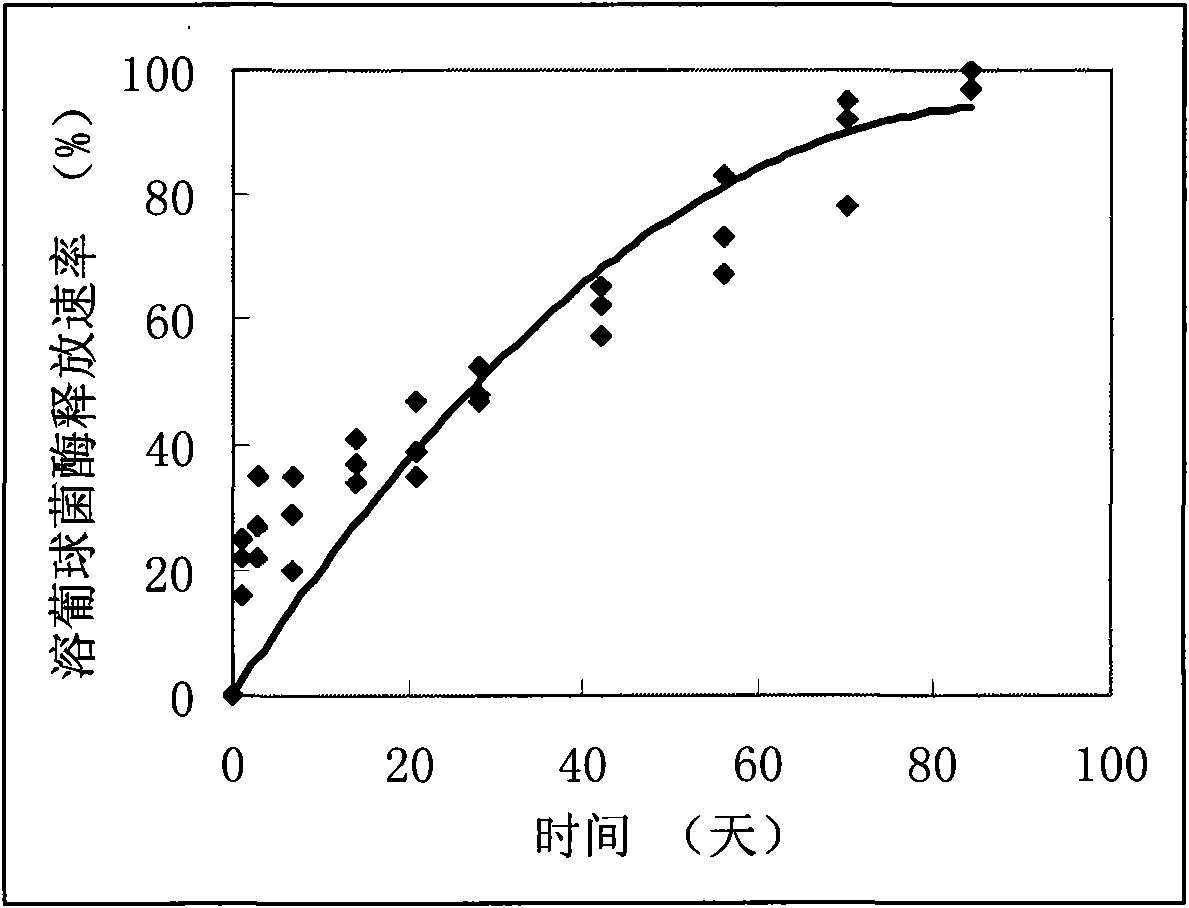Local sustained release preparation for preventing and treating osteomyelitis, preparation method and application thereof
A slow-release preparation, osteomyelitis technology, applied in the field of local slow-release preparations of lysostaphin, can solve the problems of reducing the strength of bone cement, and achieve the effect of fast degradation rate, high ratio and strong stability
- Summary
- Abstract
- Description
- Claims
- Application Information
AI Technical Summary
Problems solved by technology
Method used
Image
Examples
Embodiment 1
[0036] The preparation of embodiment 1 lysostaphin-polylactic acid microspheres
[0037] 1. Preparation of lysostaphin solution: Weigh 10 mg of lysostaphin freeze-dried powder, dissolve it in 10 ml of dimethyl sulfoxide (DMSO), and prepare a 1 mg / ml lysostaphin solution.
[0038] 2. Preparation of PLA-PLGA organic solution: Weigh 0.4 gram of polylactic acid polymer with a molecular weight of 30,000-50,000, 0.1 gram of polylactic acid-polyglycolic acid with a molecular weight of 30,000-50,000 (wherein the ratio of lactic acid to glycolic acid is 75: 25) The polymer was dissolved in 10 ml of dichloromethane to prepare a 5% PLA-PLGA solution.
[0039] 3. Slowly add 5% PLA-PLGA solution to the prepared lysostaphin-DMSO solution drop by drop, set aside.
[0040] 4. Equilibrium supercritical CO 2 Fluid, process temperature 37°C, pressure 13.5MPa, CO 2 The flow rate is 20g / min, pumped through the nozzle, and the above-prepared lysostaphin solution is prepared by supercritical anti-s...
Embodiment 2
[0042] The preparation of embodiment 2 lysostaphin microspheres-calcium phosphate bone cement
[0043] 1. Take by weighing 6 grams of ultrafine α-tricalcium phosphate powder, 4 grams of ultrafine calcium hydrogen phosphate powder, and 1 gram of the lysostaphin-PLA-PLGA drug-loaded microspheres prepared in Example 1, mix evenly, and form solid phase powder;
[0044] 2. Prepare 2% Na 2 HPO 4 (pH6.5) liquid phase solidification solution, mix 4ml of liquid phase solidification solution with the solid phase powder prepared above to form a paste, pour it into the mold, put it in a 37°C, 100% humidity environment, and release the material after solidification Made into artificial bone blocks.
Embodiment 3
[0045] The in vitro sustained release curve of embodiment 3 lysostaphin-polylactic acid microspheres
[0046] Take the artificial bone block prepared in Example 2, weigh it, place it in 100ml of PBS buffer solution (pH7.4), seal it, and vibrate at a constant temperature and speed (100r·min-1) at 4°C. The buffer solution was taken regularly within three months, the enzyme activity of lysostaphin was detected, and the cumulative release percentage of lysostaphin was calculated. The in vitro drug release results of sustained-release lysostaphin microspheres are as follows: figure 1 Shown:
[0047] The results show that the release process of lysostaphin in vitro lasts up to three months, the release rate is relatively stable, and it can maintain stable and long-term release at the administration site.
PUM
| Property | Measurement | Unit |
|---|---|---|
| The average particle size | aaaaa | aaaaa |
Abstract
Description
Claims
Application Information
 Login to View More
Login to View More - R&D
- Intellectual Property
- Life Sciences
- Materials
- Tech Scout
- Unparalleled Data Quality
- Higher Quality Content
- 60% Fewer Hallucinations
Browse by: Latest US Patents, China's latest patents, Technical Efficacy Thesaurus, Application Domain, Technology Topic, Popular Technical Reports.
© 2025 PatSnap. All rights reserved.Legal|Privacy policy|Modern Slavery Act Transparency Statement|Sitemap|About US| Contact US: help@patsnap.com

